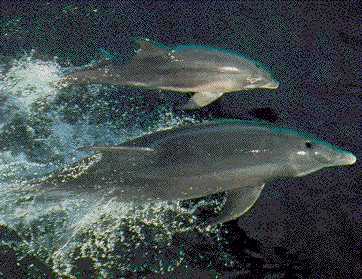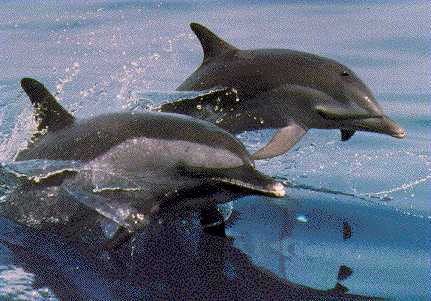THE CD OF THE PROJECT:
KAIROS - HUMAN / DOLPHIN RESEARCH
ACTIONS AND MUSICAL INTERACTIONS WITH FREE-RANGING WHALES AND DOLPHINS
This CD is dedicated to all whales, dolphins and to "homo sapiens musicus": that promising subspecies of the human being, which learns to communicate by sound and rhythm. For dolphins and whales this is nothing notable: For them, world is sound. By whistles and clicks they can communicate precisely over long distances. For millions of years, whales and dolphins have developed a fascinating way of life. Their life is play, and their language is music. Their communication system makes it possible to live in a permanent state of direct transparency. When we come in contact with the cetaceans, it is possible to rediscover our dormant communication potential.
Why not bring musicians and dolphins together? One
kind of interspecies- communication are the joyful jamsessions, the
meditative
 question-and-answer-chorals
or the whistling smalltalks that take place between humans and animals on
board the Human/Dolphin Research Ship KAIROS. The KAIROS is a research ship
for creating new experiences both in and above the water, and for a new way
of communication between human beings. It is a place to meet with the whales
and dolphins, as well as with the elements of nature. Since 1993 musicians,
bands and choirs of different genres and professionality undertake music-crusings
on KAIROS. The 25 meter long double-mast-motor-sailer was built specifically
for Human/Dolphin-Research.
question-and-answer-chorals
or the whistling smalltalks that take place between humans and animals on
board the Human/Dolphin Research Ship KAIROS. The KAIROS is a research ship
for creating new experiences both in and above the water, and for a new way
of communication between human beings. It is a place to meet with the whales
and dolphins, as well as with the elements of nature. Since 1993 musicians,
bands and choirs of different genres and professionality undertake music-crusings
on KAIROS. The 25 meter long double-mast-motor-sailer was built specifically
for Human/Dolphin-Research.
KAIROS is equipped with a sound studio for two way
communication above and under
 water.
The KAIROS does not work in the usual scientific way. Instead, we become
researchers of ourselves and the world. Following our natural curiosity and
zest for life, we do not simply observe the events going on around us, but
take part actively in everything that happens.
water.
The KAIROS does not work in the usual scientific way. Instead, we become
researchers of ourselves and the world. Following our natural curiosity and
zest for life, we do not simply observe the events going on around us, but
take part actively in everything that happens.
What you hold in your hands, are the hits of two years Actions and Interactions with free ranging Whales, Dolphins and Humans. Pilotwhales, Spermwhales, Bottlenose Dolphins, Common Dolphins, Musicians, Singers, Sailors and Technicians - together they produced a real sampler.

It is everything your ears can experience on KAIROS: Listen, sharpen perception and give yourself to the underwater trance. Witness the musical conversation with an "extraterrestic intelligence" culminating in an interactive reggae session.
Contents of the CD
1. Globicephala Soundwave Meditation
Los Cristianos/Tenerife Sept.`94 and Berlin, Winter `94/95
Only three crew members (Crack, Bettina and Ulisses) are on board. Pilotwhales come. Ulisses swims with them alone and falls into the Pilotwhale dreamtime. Back in Berlin he recreated the adventure in the music studio.
Music + Instruments: Ulisses Reinartz
Didjeridoo: Peter Trom
Vocals: Globicephala macrorhynchus - Pilotwhales
Produced by : Olaf Wilms, Ulisses Reinartz, KAIROS Ltd. and Interzone
Studio
2. Rolling Drums with Pilotwhales
Madeira, May `95
At night we are rocking gently a few sea miles not far off Funchal/Madeira, when we heared a group of 30-40 Pilotwhales over the hydrophone. Crack, Alex and Ulisses take their drums and tune into their rolling rhythm of the clicks. The whales come directly to the boat.
 3. Pilotwhale Duet
3. Pilotwhale Duet
Tenerife, Sept. `95
Unusual duet of two pilotwhales with the typical underwater echo of the bay of Los Cristianos. Probably an example how the pilotwhale baby learns its signature whistle.
4. Echo-Song
Tenerife, March '94
Indian Song with Humans, Pilotwhales and Common Dolphins. In the early morning we meet 30-40 Pilotwhales, who drift along silently on the watersurface. Their heads turn all in our direction when the people on board sing the Indian echo-song. At the same time we can hear their their answers over the deck speakers. Suddenly, Common Dolphins tune in.
5.Hello Humans!
Madeira, April `95
Uncommon sounds of Common Dolphins. Their initial contact sounds appear like imitating humans.
6. Hello Pilotwhale!
Madeira, May '95
A single Pilotwhale takes a look at the KAIROS. Ten minutes later we hear his "Hello": A kind of pulsing sound. This speciality of Toothed Whales consists of 500-600 Clicks per second, or even more. For our ear it sounds like barking.
7. "Talking" Tursiops and Clicking Spermwhales
Madeira/Porto Santo, April '95
Bottlenose Dolphins (Tursiops truncatus) squeak, while Spermwhales click in the background.
8. Pottwalsolo
Madeira/Porto Santo, April '95
Different rhythms of the repertoire of Spermwhales. Between 6 p.m. and 2 a.m. we hear four or five of these biggest Toothed Whales clicking. They let us into an eight hour trance. We are not sure wether we see any of the whales in this cloudy night. But their clicks sound as if they come from directly under the ship. Anyway: for the musicians the acoustic contact is important.
The clicks of the Spermwhales don`t only serve as echolocation to observe the ocean ground and find food. It`s also a medium of communication for them.
9. Bottlenose Dolphins: Let`s talk together
Madeira/Porto Santo, April '95
 We have listened half of night to the clicking Spermwhales.
Now 20 Tursiops come to the ship and mingle in.
We have listened half of night to the clicking Spermwhales.
Now 20 Tursiops come to the ship and mingle in.
10. Bottlenose Dolphins: low frequency clicks
Madeira/Porto Santo, April 95
The Dolphins make a Tohuwabohu as if they want to test our hydrophon system. Among the sounds are unusual clicks with low frequencies.
11. Lonesome Whale Reggae (Do you hear me)
Tenerife, March `94 and Berlin, Spring `94
A life session between a Pilotwhale and Ulisses with drum was the base for this Reggae. The original rhythm was kept when he later in the studio recorded the other instruments and vocals.
Music, text und instruments: Ulisses Reinartz Percussion: Thomas Ritthoff , Vocals: Ulisses and Pilotwhale, Produced by: Olaf Wilms, Ulisses Reinartz, KAIROS Ltd. and Interzone Studio
Do you hear me, do you hear me
now, Do you hear me, in your dreams?
Do you hear me when I'm crying, I'm a calling from the dark.
Where's my homeplace in the blue? Do you hear me calling you?
Do you hear me, do you hear me
now, Do you hear me, in your dreams?
Do you hear me, do you hear me now, Do you hear me, in your dreams?
When you`re leaving in the evening,
I hear your echos from the deep.
Then I know that I'm not lonesome, then I know you're, you're by my side.
Then I know that I'm not lonesome, then I know you're, you're by my side.
12. Whistle-Smalltalk
Tenerife, March '94.
Almut (one of the crew) whistles on the whale pipe into the microphone. Pilotwhales answer and imitate her sounds. A situation of the early days of our interactions. On one channel you hear the human, on the other the answers of the whales. Is that already a kind of communication? At least a kind of listening to each other.
COLLECTION OF DIFFERENT CETACEAN SOUNDS
13. Whistles which are produced often:

A + B: Bottlenose Dolphins (Gomera)
C + D: Pilotwhales (Tenerife)
14. Repeated Whistles:
A: Pilotwhale (Tenerife) B: Pilotwhale (Madeira)
15.Rare Whistles:
A,B,C + D: Pilotwhales (each repeated 3 times)
16. Human being checked by means of clicks:
A: Tursiops (Gomera) B: Pilotwhales (Tenerife)
17. Clicks at the hunt:
A: Pilotwhale (Tenerife) B: Spermwhale (Madeira)
18. Unusual Series of clicks:
A: Tursiops (Madeira) B: Pilotwhale (Tenerife)
19. Unusual Pulse Sounds:
A + B: Pilotwhales C + D: Common Dolphins